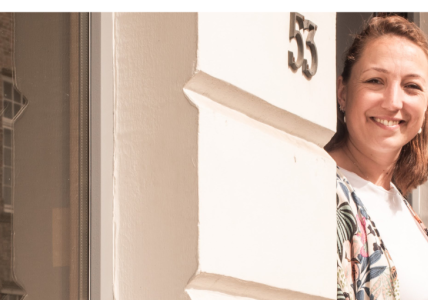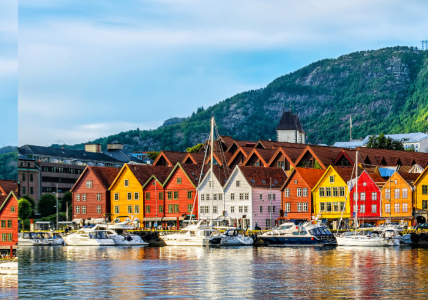Farming to save the planet: The CANAPE project tested new peatland restoration methods and explored the benefits for local communities. We developed products from sustainable use of peatlands, raised community awareness, and provided decision-making tools for farmers and politicians.
Peatlands, found in tropical and temperate regions, are wetlands with decomposed organic matter called peat. They support diverse plant and animal species, including unique carnivorous plants and rare birds.
Peatlands are crucial for carbon sequestration and climate regulation, storing double the carbon of all forests despite covering just 3% of earth’s land. Conserving and restoring peatlands can mitigate climate change and support sustainability goals.
Additionally, peatlands act as natural water filters, improving water quality, regulating flow, and replenishing water sources. They also create groundwater reservoirs for clean water supply.
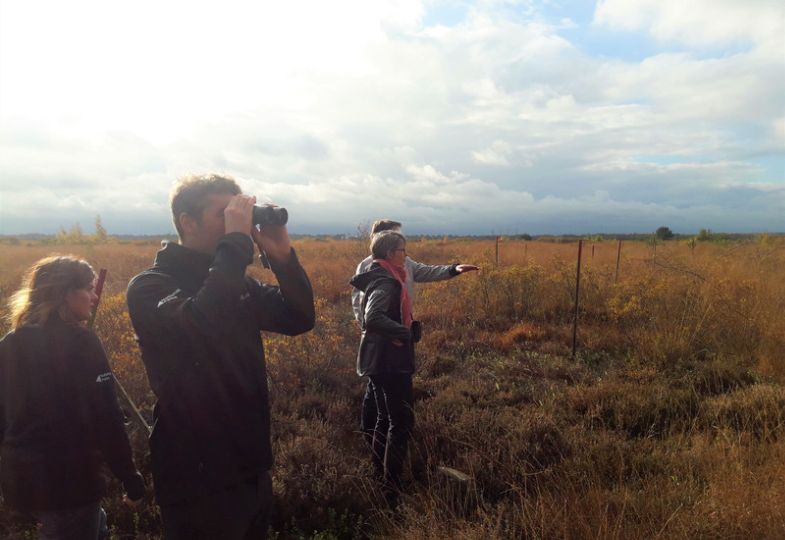
CANAPE ecologists exploring a bog in Lower Saxony.
However, in the North Sea Region, peatlands have been drained for agriculture and extracted for garden compost, releasing stored carbon and contributing to greenhouse gas emissions. This also destroys their water storage and filtration functions.
Restoration efforts have made progress, but restoration for establishing nature reserves will not be enough to meet Europe’s Net-Zero goals. Therefore, CANAPE focused on a more holistic approach, carrying out restorations whilst piloting forms of agriculture consistent with rewetting peatlands.
Peatlands for the planet
We restored 81 hectares of habitat securing over 500 tonnes of CO2 per year. Additionally, this provides added water storage of 172,000 cubic metres. These sites offer significant biodiversity benefits, plus the potential for some water cleaning services.
The restoration works covered three sites:
De Nol in the Grenspark Kalmthoutse Heide in Belgium is a 60-hectare bog that suffered from poor water retention. With the CANAPE restorations it is rewetted and fits into a mosaic of special landscapes in the Grenspark area.
Zuidlaardermeer in the Netherlands is a beautiful shallow lake close to the City of Groningen, with substantial recreation and wildlife value. The lake has however been in a poor ecological state for some years. The CANAPE project supported the creation of 20 hectares of new reedbed on its edges, improving the water quality and developing a wider plan for restoration.
Hickling Broad in the Broads National Park in the UK is the largest lake in the Broads National Park, formed from flooded medieval peat excavation. As a result of nutrient pollution there was a loss of plant life, causing parts of the banks to collapse and the reedbed to retreat. CANAPE restored one hectare of former reedbed, whilst dredging the surrounding channels to reduce the sediment stirred by passing boats.
CANAPE boosted the partners' technical skills in understanding the impact of their restoration projects on greenhouse gas emissions. We did this using the Greenhouse Gas Emission Site Type (GEST) approach.
In the UK, the Hickling Broad Site also saw a trial of the use of biofuel in the Broads Authority fleet, using a modern waste cooking oil derivative called Hydrotreated Vegetable Oil. This has significantly reduced the CO2 emissions associated with machinery use at the site, and the overall footprint of the Broads Authority.
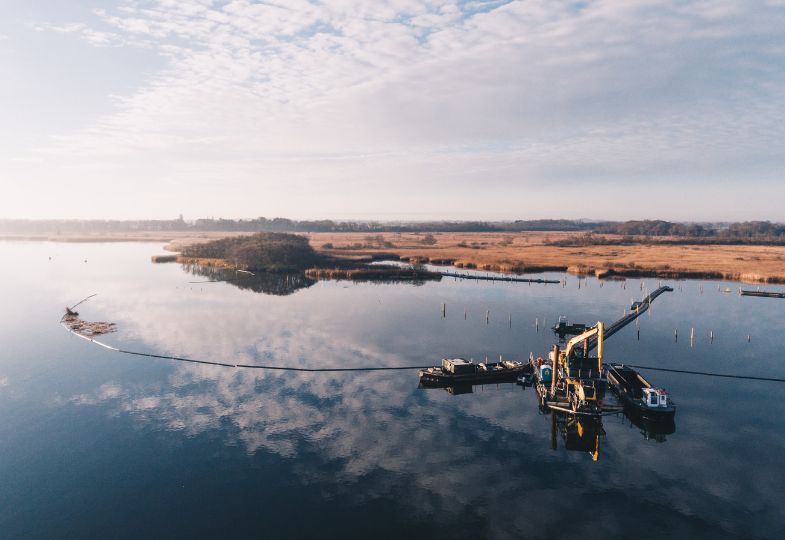
Restoration work at Hickling Broad in the Broads National Park. Photo: Broads Authority.
Alongside the restoration projects, project partner VHL University of Applied Sciences carried out an extensive research project in Lake de Leijen in the Dutch Province of Friesland. Some fish species, such as bream, can make it harder to restore aquatic plant life and improve water quality due to their habit of whirling up the sediment in search of food.
VHL installed a network of “receivers” on wooden poles across the lake, and attached trackers to fish. Their movements around the lake were then compared with data on spatial water quality. Based on this, the team discovered hotspots for bream activity and identified the best places to start regenerating aquatic plants.
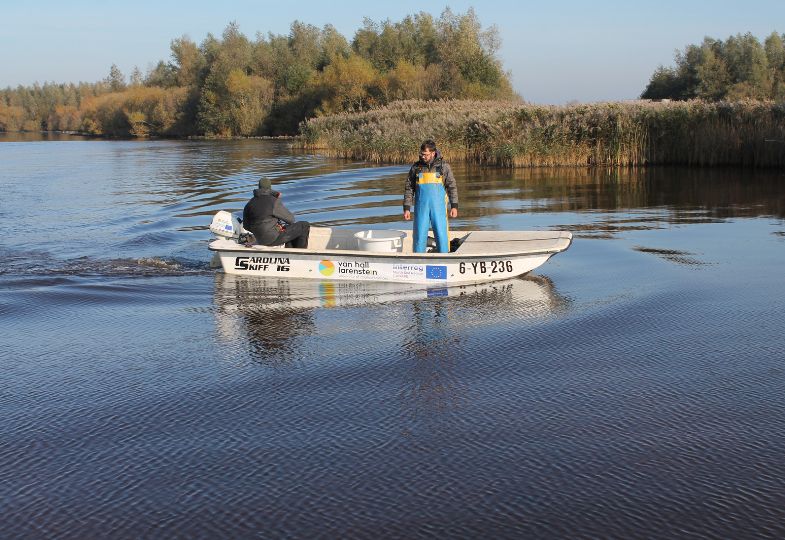
Researchers in action at the Lake de Leijen.
Peatlands for communities
To safeguard healthy peatlands, communities that live and work in peatlands need to have a prosperous future. This includes finding ways that the use of peatlands can produce an income whilst protecting the planet, and allowing communities to be connected to an understand the value of the peatlands that surround them.
We developed several citizen science approaches. Bioblitzes, where people spend 24 hours hunting for plant and animal species in an area, gave schoolchildren first-hand views of the conservation value of bogs.
To gather data on peat depth, students carried out corings, building maps of peat depth in fens. In Germany, the public were asked to report sightings of tagged fish, to understand how far fish travel through the canal & river system, supporting our research pilot there.
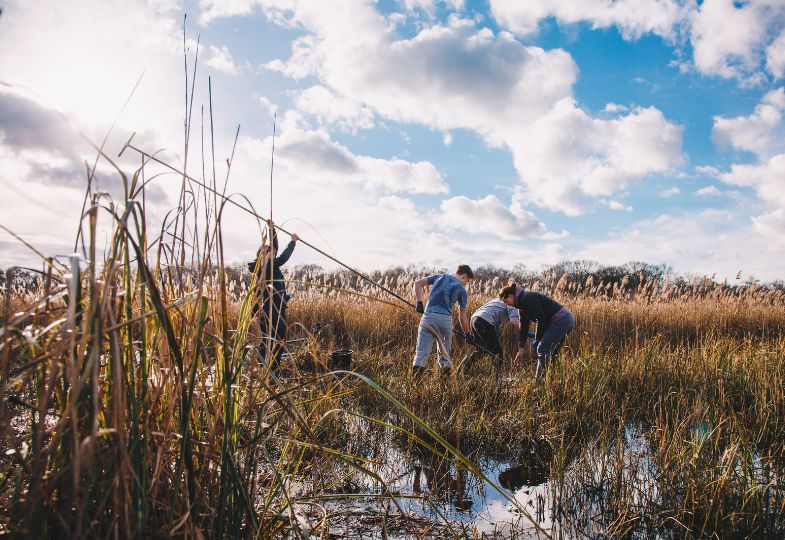
Collecting soil cores with students. Photo: The Broads Authority.
Peatland products
A key part of the peatland puzzle is finding profitable uses for wetlands. With the scale of rewetting needed, much of it on agricultural land, restoration purely for nature is unlikely to lead to rewetting of enough land.
Therefore, we trialled a range of production methods from wet soil. This included re-use of waste from nature conservation and constructing innovative farms to farm wetland products. The re-use of waste can help reduce the costs of nature conservation.
One example of using waste material was a trial of charcoal made from wood from wetland management. Scrub clearance and tree removal is often a necessary part of conservation. Managers of nature reserves often burn their plant cuttings onsite, as there is no buyer willing to take it away due to its low value as firewood.
CANAPE used a mobile charcoal retort to produce high quality charcoal that was sold locally and proved very popular with consumers. This will be an ongoing benefit of the project.

Ecologist Andrea Kelly observing the production of charcoal in the mobile retort.
Farms of the future
CANAPE explored various forms of peatland farming of native plants, also called paludiculture.
Sphagnum moss is a promising wetland product. If correctly dried and processed it can be used as a growing medium or potting material in the horticultural and agricultural industries. This offers an alternative for the large amount of cut peat currently used as a growing medium by these industries.
Throughout Europe, the main growing media available from former bogs is cut and harvested peat. This results in emissions of up to 200 kg of CO2 per cubic metre of garden compost - equivalent to using nearly 90 litres of petrol. Producers of growing media and compost for horticulture and agriculture are in need of alternatives to reduce their carbon footprint. Sphagnum Moss is one potential alternative, particularly for high-value orchids.
We constructed a demonstration sphagnum farm at Barver Moor in Germany. In the longer term, the maintenance of the site will pass to the MOOSland project.
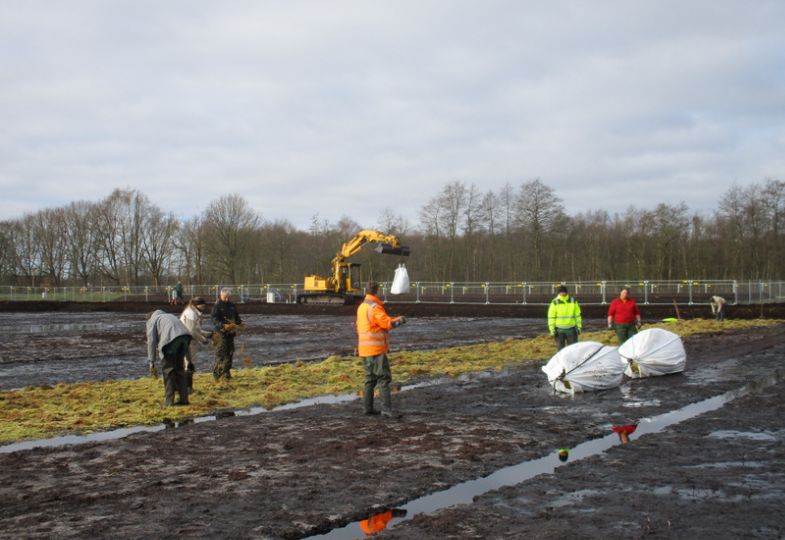
Planting Sphagnum at Barver Moor, Lower Saxony
Typha Latifolia, known as Cattail or Reed Mace,is another wetland plant that has great potential as a wetland crop. There is a huge range of potential uses for Typha, from use in building and making woven rush materials, to use in constructed wetlands to absorb pollutants and purify water. These wetlands are sometimes known as green filters, and are used as a cheap way to clean sewage water. It is even possible to eat them - although because of their capacity to absorb pollutants from water this should only be done with cattail harvested from very clean water bodies.
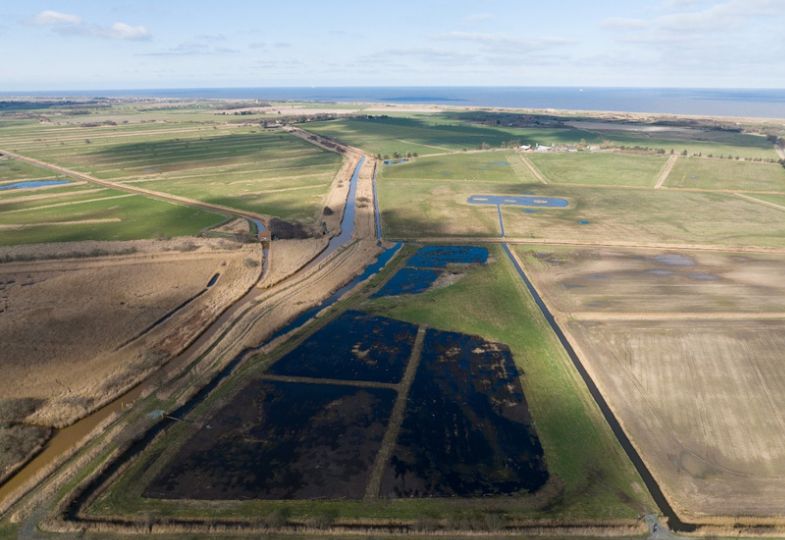
A Typha and Phragmites farm built by CANAPE in the UK, on the Horsey Estate in the Broads National Park.
CANAPE built two pilot farms for Typha, in the UK and Denmark, including the first-ever paludiculture trial in Denmark. The versatility of Typha has immediately grabbed farmers attention, with over 1,000 visits so far to the Horsey Pilot Farm.
Expanding Phragmites reed was another focus of the project. Reed, used for thatching, is a well-established product, however there is limited experience in constructing new reedbeds for commercial use. Western Europe also imports substantial amounts of reed, showing that demand outstrips local supply.
At our Horsey Wetland Farm, we are now trialling the establishment of new commercial standard reedbeds as one of the two crops tested during CANAPE, working closely with local reedcutters.
Learn more about our work in this video:
What the Peat Crew are doing next
In July of 2023, six months after the end of activities of the project, the partners met online to discuss their new projects and work plans. All of the partners are continuing to push forward with their work on peatland. In the Broads, the peatland products were showcased at the Royal Norfolk Show, the largest agricultural show in the UK, including to the Minister of State for Farming, and former Prime Minister Liz Truss.
In Denmark, a large-scale rewetting project is being worked up in Store Vildmose. In Germany the Moss Farm is forming a regional hub of paludiculture knowledge. In the Netherlands, one of the Project team has changed career to launch his own paludiculture consultation business, with the first order of business being to help the establishment of a 35-hectare Typha farm.
In Belgium our partners have already launched their new Interreg Project, Interreg ADMIRE, and our Dutch partners have launched Interreg Buffer+ and Interreg Blue Transition, all building on knowledge gained through the past round of Interreg.
As governments across Europe pursue rewetting as part of their net-zero ambitions, the international knowledge sharing and tool creation will remain as important as ever. To get to net-zero by 2050 we don’t have time to reinvent the wheel in each country individually.
Peatlands are ancient irrecoverable carbon stores. Mysterious homes offering refuge to migrating birds, rare flora and fauna and unique biodiversity. They provide much needed protection from droughts and floods. Although largely unknown and often overlooked, they matter – for the climate, for people and for our planet’s future. Peatlands urgently need our protection and restoration efforts. We need to deepen our understanding of these precious ecosystems and inspire forward thinkers to invest in their conservation and sustainable management.
Top 3 project highlights
Paludiculture in practice
CANAPE constructed three paludiculture sites, trialling different native crops and developing business cases for each one.
Rewetting and restoring peatlands
CANAPE conducted restoration projects in eight sites across the North Sea Region,saving 500 tonnes of CO2 per year in total.
Engaging communities
The project raised awareness of the importance of peatlands and the potential of paludiculture among the local communities, involving students, school children, farmers, and local enterprises.
Tools for restoration
The CANAPE partners produced two guides sharing the insights we gained through our cooperation.
Your Pocket Guide to Sustainable Farming
This guide presents the business opportunities for rewetting peatland soils, and is aimed at anyone who is farming or working on currently drained lowland peats. It summarises paludiculture for those farmers and landowners on peatlands who are looking for a wetter future on their land.
The guide, available in German, Dutch, English, and Danish, also signposts people to where they can learn more and get in touch with local contact points who can guide them further on their paludiculture journey.
Peatlands Across Europe Policy Guide
In 2021, following a series of online workshops bringing together partners across Europe from 5 peatland projects, we produced a guide of shared experiences, and recommendations for policy makers. The guide set out the various challenges for peatlands, and to maximise the climate, biodiversity and economic benefits of these incredible landscapes
Learn more
More information about the project can be found at the CANAPE website.
Find our five “CANAPE Chats” videos covering various project aspects here.
Find videos of presentations from our conference “Sustainable Peatlands: A Win for all” here.
Get in touch
To learn more or cooperate, please contact project manager Harry Mach at harry.mach@broads-authority.gov.uk
About the author
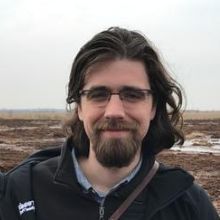
Harry Mach works at the Broads Authority as the Climate Change lead.
He works on projects to cut the footprint of the Broads National Park and support the local communities on their journey to Net-Zero.
Top photo: Restoration work at Hickling Broad in the Broads National Park / courtesy of the Broads Authority.
